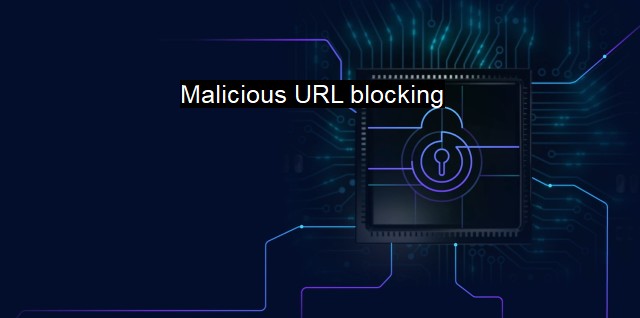What is Malicious URL blocking?
Protecting your Personal Information: Exploring Malicious URL Blocking in Cybersecurity
Malicious URL blocking is the process of identifying and blocking access to URLs that can damage a user's privacy, personal information, data integrity, or computer and network systems. A variety of harmful elements, including viruses, worms, spyware, ransomware, and Trojan horses are often hosted on these sites. They are built with the express purpose of exploiting user's vulnerabilities and potentially damaging the workstation, transferring sensitive information to remote servers or coercing users to share sensitive information unwittingly.Where immense quantities of data are continuously being exchanged, cybersecurity and, more specifically, malicious URL blocking, has become ever more critical. Attackers often exploit ordinary websites by injecting malicious scripts into them. When users visit these infected sites, their computers can be silently compromised. Such URLs can also lead users to phishing sites that aim to trick them into revealing personal or financial information.
Organizations around the world spend significant resources faced with the challenge of overcoming these potential cyber threats. An integral part of their defense strategy is implementing efficient measures to block malicious URLs. Blocking these harmful portals is a central component in defending an individual user or an entire network from various forms of cyberattacks.
The act of malicious URL blocking involves diverse techniques like blacklisting, cloud-based analysis, real-time analytics, artificial intelligence, and machine learning. URL blacklisting, which is the earliest method used, works by keeping a continuously updated list of URLs known for distributing malicious content. On the contrary, AI and machine learning developed recently make anticipatory blocking possible by identifying typically suspicious traits in websites.
Real-time analytics take this a step further. They monitor data transfer in real time, which helps in identifying and blocking malicious URLs whenever a user clicks on one accidentally. Cloud-based analysis shares information about malicious URLs globally. Once one domain detecting a malicious URL, the cloud-based network spread the word to protect various other users from landing on the same page.
Malicious URL blocking is not an ultimate shield against cyber threats. No software can guarantee a hundred percent protection from all cyber threats. Malicious URLs can be hosted in legitimate sites as well through malvertising or state-of-the-art exploits, making them harder to detect. Nonetheless, it significantly reduces the risks posed by most known threats.
On an individual level, cybersecurity tools having malicious URL blocking is certainly recommended. Often it’s unseen and might be layered with a high-quality antivirus program that prevents any detected malware from running on your system. A program equipped with malicious URL blocking is essentially maintaining a fortress around your cyber presence, blocking incoming attacks stealthy and overt.
No cybersecurity tool gives a comprehensive shield, and no technology can save you if you willingly give access to harmful content, for instance, by clicking on a phishing mail link. A human error can nullify even the most sophisticated malicious URL blocking techniques, where threats enter via behavioral loopholes. Hence, cybersecurity awareness plays a vital role in digital wellbeing.
Numerous advances in pattern-recognition and data-analysis capabilities have dramatically enhanced the potential of malicious URL blocking. It has become an integral part of modern cybersecurity arsenal. Accompanied by the continuing improvements in AI and machine learning, it potentially gears up to spearhead the campaign against the relentless innovativeness of cybercriminals. Helped by user awareness and secure digital practices, malicious URL blocking goes a long way in ensuring cybersecurity. Though these technologies hold a promising fort, complemented by smart usage, combined efforts can ensure private, safe digital spaces.

Malicious URL blocking FAQs
What is malicious URL blocking?
Malicious URL blocking is a cybersecurity technique that involves preventing users from accessing websites or links that are known to be dangerous or malicious. It is commonly used as a feature in antivirus software to protect users from phishing scams, malware, and other cyber threats.How does malicious URL blocking work?
Malicious URL blocking works by using a database of known malicious URLs to compare against the URLs that a user is trying to access. When a user attempts to access a known malicious URL, the antivirus software will block the user's access to the site and display a warning message. Some antivirus software also uses real-time scanning to detect and block unknown malicious URLs in real-time.What are the benefits of malicious URL blocking?
The main benefit of malicious URL blocking is that it provides an additional layer of protection against cyber threats such as phishing scams, malware, and ransomware. It can also prevent users from accidentally accessing harmful websites that may compromise their personal information or data. By blocking malicious URLs, antivirus software can help keep users safe while they browse the internet.Can malicious URL blocking be disabled?
Yes, most antivirus software allows users to disable or customize the malicious URL blocking feature. However, it is generally recommended to keep this feature enabled for maximum protection against cyber threats. Disabling malicious URL blocking can leave users vulnerable to phishing scams, malware downloads, and other cyber attacks.| | A | | | B | | | C | | | D | | | E | | | F | | | G | | | H | | | I | | | J | | | K | | | L | | | M | |
| | N | | | O | | | P | | | Q | | | R | | | S | | | T | | | U | | | V | | | W | | | X | | | Y | | | Z | |
| | 1 | | | 2 | | | 3 | | | 4 | | | 7 | | | 8 | | |||||||